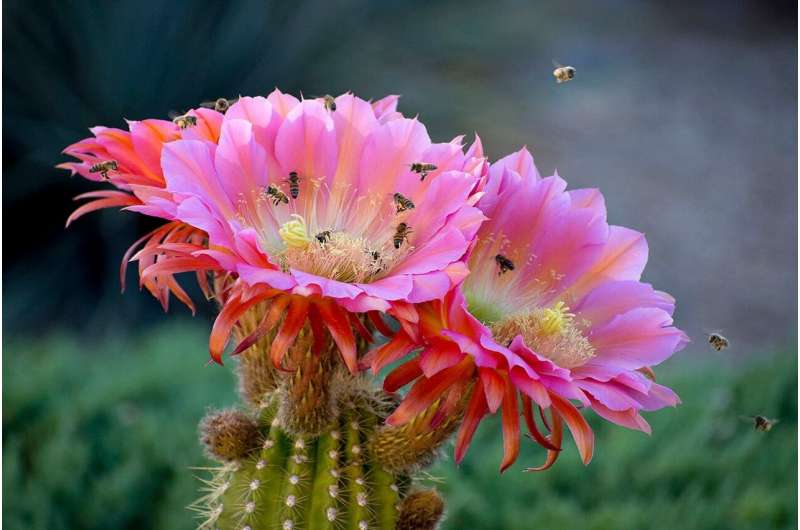This article has been reviewed according to Science X's editorial process and policies. Editors have highlighted the following attributes while ensuring the content's credibility:
fact-checked
trusted source
proofread
Researchers learn how nectar-laden honey bees avoid overheating

Honey bees carrying nectar have the remarkable ability to adjust their flight behavior to avoid overheating when air temperatures increase, according to research led by a University of Wyoming scientist.
Jordan Glass, a postdoctoral research associate in UW's Department of Zoology and Physiology, conducted the study to determine how high air temperatures may limit the ability of honey bees to forage for nectar. His research findings appear in Proceedings of the National Academy of Sciences.
Insect pollinators are declining at an alarming rate due in part to climate change. While it is thought that extremely hot, dry conditions should limit when a honey bee can forage, Glass and colleagues found that these pollinating insects have the ability to remain active in significant heat. In fact, this study showed that honey bees can carry the same amount of nectar without a threat to their lives in temperatures ranging from 77 to 104 degrees Fahrenheit.
The researchers measured the flight muscle temperatures, metabolism, and water loss of honey bees carrying nectar inside a temperature-controlled flight room to determine the insects' ability to fly at high air temperatures. And to determine how carrying nectar might change the flight behavior, the scientists also used high-speed videos of the flying bees to measure changes in how they flap their wings.
Specifically, their results demonstrated that the honey bees' flight muscle temperatures and metabolism increased while carrying nectar at 68 and 86 degrees. However, at 104 degrees, muscle temperatures did not change, and flight metabolism only slightly increased with increasing nectar loads.
Analysis of the high-speed videos of honey bees flying at air temperatures of 77 and 104 degrees showed that, at high body temperatures, "bees apparently increase flight efficiency by lowering their wingbeat frequency and increasing stroke amplitude to compensate, reducing the need for evaporative cooling," wrote Glass, who led the research as a doctoral student at Arizona State University.
In other words, as temperatures rise, the bees change how they fly to decrease the heat they generate from metabolism, which helps these insects avoid overheating and save precious water.
"Due to the capacity of hot bees to reduce metabolic heat production during flight, our data suggest that, under dry and poor forage conditions, (dehydration) may limit activity before overheating, impairing critical pollination services provided by honey bees," Glass wrote. "Even with reductions in metabolic heat production, (dehydration) likely limits foraging at temperatures well below bees' critical thermal maxima in hot, dry conditions."
Although the findings from this study relieve some concern about the impact of a warming climate on honey bees, Glass says there is still reason for worry as the world becomes warmer and drier.
More information: Jordan R. Glass et al, Flying, nectar-loaded honey bees conserve water and improve heat tolerance by reducing wingbeat frequency and metabolic heat production, Proceedings of the National Academy of Sciences (2024). DOI: 10.1073/pnas.2311025121
Provided by University of Wyoming



















